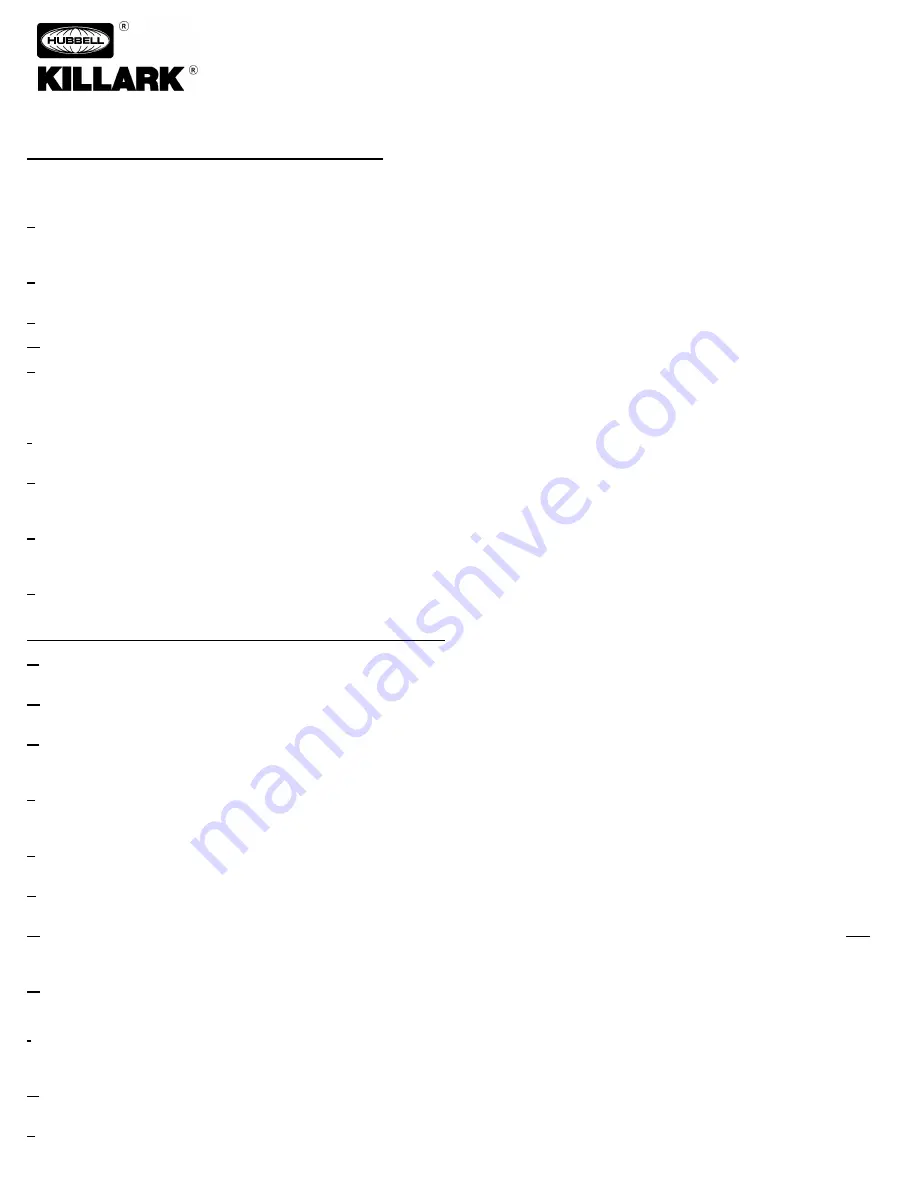
HUBBELL ELECTRICAL PRODUCTS
A Division of HUBBELL INCORPORATED (Delaware)
3940 Dr. Martin Luther King Drive
St. Louis, Missouri 63113 USA
INSTALLATION, OPERATION &
MAINTENANCE DATA SHEET
SERIES USF JUNCTION BOXES
Increased Safety Terminal Enclosures For Use In
Zone Classified Hazardous Locations
P/N KIL00921445 FORM NO. K1445 R6/18 ECO-2-045-18
Page 3 of
10
Enclosure and Cover Installation Instructions
WARNING: Enclosures that are powder coated have a potential electrostatic charging hazard. Wipe the enclosure down with a moist cloth
before servicing.
a:
Using a screwdriver with a #2 Phillips Head, a Standard Slotted or Robertson style head, remove the cover screws. Securely fasten the
enclosure to the mounting location, using up to a
1/4” (M6)
diameter steel bolt and washer. The mounting location must be flat and provide
proper clearance, rigidity and strength to support the enclosure and all contained devices. Mounting dimensions are shown in this document.
b:
Install Internal Components per the Mfrs. installation instructions. (See
"Wiring and Terminal Block"
and
"Cable Gland / Conduit Entry"
Installation Instructions
Sections below).
c:
Grounding connections are available at the din rail, earth continuity plate and internal- external ground stud.
d:
Bonding connections are available on covers and boxes of all enclosures. All exposed metal should be bonded per local electrical codes.
e:
Closing / Installing the enclosure cover: Thread each cover screw half way into the threaded insert without completely tightening in a diagonal
pattern. Then complete installation of cover by tightening screws in the same diagonal pattern to a minimum torque of 3 Nm (26 lb-ins.) to a
maximum of 4 Nm (35 lb-ins.).
DO NOT OVERTIGHTEN OR USE AN IMPACT TOOL. A consistent fit over the entire length of the cover joint
should be verified at the time of installation.
f:
This enclosure is provided without cable glands / conduit sealing devices. Proper selection of cable glands / conduit sealing devices must
occur in the field.
g:
Cable fittings must be certified “Ex e” components per EN 60079-7. For lines which are not permanently installed, only cable fittings
appropriate for this purpose can be used. They are to be protected from loosening and locked against rotation, i.e. clips, cemented, etc., per EN
60079-7. The operating (service) temperature of the enclosure is limited to the temperature of the gland fitting if less than the enclosure
.
h:
Killark KDE series drain and breather may be installed. The operating temperature of the enclosure is limited to the temperature of the drain
and breathers if lower than the enclosure's.
Other drain and breathers may be installed, the user is responsible for ensuring that the
protection concept, temperature class and relevant IP rating is maintained.
i:
All unused conduit openings must be fitted with a certified close-up plug of equivalent minimum required IP rating as required.
Terminal Block Installation and Wiring Instructions:
a:
Attention to detail is highly recommended when installing and wiring the Terminal Blocks. Proper installation is required to ensure the
component Certification Ratings are not invalidated.
b:
Care should be taken not to damage or crack the DIN-Rail mounting clips when removing or installing polymeric terminal blocks.
Damaged or
loose-fitting terminal blocks should be replaced before energizing the device.
c:
Refer to each Terminal Block Manufacturer's Installation Instructions for suitable wire types (ie: Solid, Stranded), proper wire stripping lengths,
and terminal torques.
OVERTIGHTENED or
LOOSE WIRE TERMINALS MAY CAUSE OVERHEATING, WHICH CAN RESULT IN AN
ELECTRIC SHOCK OR EXPLOSION HAZARD
.
d
Care shall be taken to ensure proper separation of circuits (voltages), and spacings (creepage and clearance distances between live parts of
opposite polarity, and between all live parts and dead metal) are maintained. Refer to IEC/EN/UL/CSA 60079-7, Table 2, for minimum creepage
and clearance distances.
e:
Grounding connections are available at the din rail, earth continuity plate and internal- external ground stud. Bonding connections are
available on covers and boxes of all enclosures. All exposed metal should be bonded per local electrical codes.
f:
Wiring must be carried out in accordance with the relevant local and national electrical codes (ie: IEC/EN 60079-14, IEC/EN 61241-0 and
IEC/EN 61241-1.
g:
All conductor insulation and terminal block service temperature ratings shall be suitable for (exceed) the minimum ambient and
maximum temperature (defer to T-Code) achieved in service. All conductors shall be sized per the National or Local Electrical Codes
for the max. continuous current or max. motor load of the installation.
h:
C
onductors at entry points may reach 73
o
C in a +55
o
C ambient, and may reach 108
o
C in a +90
o
C ambient.
i
:
Only the terminal blocks listed on Killark certificates may be installed in the enclosures. See
Table A
below.
j:
No more than one conductor shall not be permitted in a wire terminal, unless the device has been evaluated specifially for multiconductor
installation (See Terminal Block Mfr's Installation Instructions). Ferrules may be used if the Terminal Block has been approved for use with Solid
Wires of equivalent diameter.
k:
When installing Terminal blocks, the maximum voltage, current and dissipated power shown on the Junction Box nameplate must not be
exceeded.
l:
When Weidmuller
WDU 1.5 or WDU 2.5
Series Terminal Blocks are installed, they are limited to a
maximum current of 15A
.




























